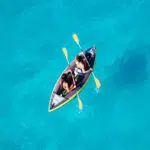National Canoe Day is celebrated on June 26 every year. Though it is a Canadian holiday, it’s celebrated in the U.S. as well. Canoeing is both a sport and a recreational activity — one that’s relaxing and good for the environment. Wherever there is water, there are canoeists. On National Canoe Day thousands visit their favorite waterways, exploring their lakes and rivers or participating in competitive aquatic events. Canoeing is a fun activity that’s easy to learn and friendly to people across different age groups. It’s also a low-impact form of exercise, so it’s good for your health too.
History of Canoe Day
Canoes have been around for millennia and used by different cultures and civilizations throughout the ages. The oldest canoe in existence dates back to 8000 B.C. It was carved out by hand with basic flintstone tools from the hollowed-out trunk of a pine tree. Canoes predate the arrival of Europeans on the American continent. They were widely used as a method of transport, catching food, trading items, and even in warfare.Native Americans used canoes made of birch-bark trees, tying together strips of wood with strong roots, then sealing them up with a pitch to prevent leakage. In 3500 B.C. the design of South American canoes was simpler but still effective. They made their boats from hollowed-out logs, which they expanded with heat and sharpened on both ends. This made them cut through the water faster. Around 1500 B.C. Polynesians had very elaborate, colorful canoes equipped with sails and crossbeams. They were much larger and sturdier than conventional canoes as their purpose was ocean voyages.By the 19th century, the techniques and technology for building canoes had evolved thanks to centuries of interaction with Europeans. Canoeing became a popular activity in the Western world as a result of this. In a world when ships and railroads existed, there was no need for canoes to be utilized for maritime transportation. Instead, Europeans used them for recreational and sporting purposes. John MacGregor, an English explorer who popularized canoeing in the United States and Europe, created the Royal Canoe Club of London in 1866. This was followed by the “American Canoe Association” formed in 1880. In 1946, the International Canoe Federation was founded, acting as the umbrella body for national canoe organizations worldwide.
Canoe Day timeline
Canoeing debuts as an Olympic demonstration sport at the Paris Olympics.
William Hoffman, Vice President of Grumman Aircraft Engineering Corporation, comes up with an idea for a lightweight canoe made of aluminum.
The ‘Pesse’ canoe — considered the world’s oldest known boat — is discovered in the village of Pesse in the Netherlands.
The ‘Dufuna’ canoe — the second oldest canoe — is discovered by a cattle herdsman in Nigeria while he is digging a well.
Canoe Day FAQs
What is a canoe person?
A canoe person or canoeist is someone who paddles a canoe.
How many miles can you canoe in a day?
You can canoe for roughly 20 miles in one day, factoring in things like speed and mileage. This adds up to about seven hours of non-stop paddling for an entire day, with breaks in-between.
How difficult is it to canoe?
Canoeing is not a difficult task. Most people learn how to paddle solo canoes in an hour or two.
Canoe Day Activities
-
Go for canoe lessons
Learning how to row a canoe is a great way to celebrate National Canoe Day. It’s not a difficult skill to pick up at all, it just takes a bit of practice and dedication. You can learn with a solo canoe, a two-person canoe for someone special, or a four-person canoe for larger groups.
-
Attend a canoe race
Whitewater canoeing is an exciting sport. As you watch the races you’ll quickly realize that it takes great skill to navigate rapids without flipping over or crashing. As a spectator, you get to experience the thrill with none of the risks.
-
Buy a canoe
Buying a canoe can prove quite convenient if you live near rivers or lakes. This way you can celebrate National Canoe Day each year by taking your craft out for a spin on the water. Besides, canoeing is a peaceful, relaxing activity that keeps you in shape.
5 Interesting Facts About Canoeing
-
The longest canoe trip
In 1980, Don Starkell and his teenage sons paddled from Winnipeg, Canada to the Amazon River, covering more than 12,000 miles over two years.
-
Florida has the eldest canoes
Florida has more than 400 old, dug-out canoes preserved in their original state — the highest number in the world.
-
Hungarians are canoeing champions
Hungary has won 41 medals in canoeing since 1980, with 18 of them being gold medals.
-
Canoes are different from kayaks
Canoes have open decks with rowers sitting or kneeling inside the canoe, while kayaks have closed decks with a hole cut in the center where the rower sits.
-
Canoes were used during WW2
During Operation Frankton, canoes were used to transport commandos to raid ships in the French port of Bordeaux, which was under German occupation at the time.
Why We Love Canoe Day
-
It highlights an obscure sport
Canoeing is one of the lesser-known watersports. It doesn’t get much mainstream coverage compared to other events like swimming, sailing, or diving. National Canoe Day brings awareness to this activity and its competitive watersports variants.
-
It teaches us to appreciate the environment
Whether you’re doing it recreationally or competing in an event, canoeing takes place outdoors. On National Canoe Day, we get in touch with mother nature and deepen our appreciation for the environment.
-
It keeps canoeing relevant
National Canoe Day doesn’t just celebrate one of the oldest forms of transport and recreation. It also keeps the conversation on this activity going. Every year on June 26, more people get to know about canoeing and its history.
Canoe Day dates
| Year | Date | Day |
|---|---|---|
| 2023 | June 26 | Monday |
| 2024 | June 26 | Wednesday |
| 2025 | June 26 | Thursday |
| 2026 | June 26 | Friday |
| 2027 | June 26 | Saturday |






















